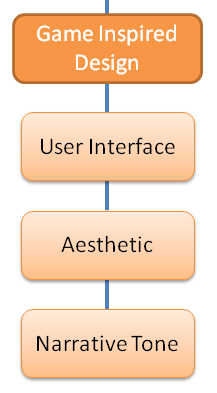Gamification of Learning Processes
From Learning and training wiki
| {{{2}}} |
It turns out that it is effective. But what makes it so effective, if it is using the same old reward systems, just dressed up in a different way? What is the difference between the old reward and the digital, visual reward? Three theories follow:
1. Game Inspired Design
As defined by Andrzej Marczewski:
“This used to be called gameful design, but this now has more gamification like connotations. This is where no actual elements from games are used, just ideas. So user interfaces that mimic those from games, design or artwork that is inspired by games or the way things are written. All of these have links to games, but do not contain anything that you would consider to be part of a game (mechancics, dynamics, tokens etc.)” [4]
The visual appeal of games is ludic, what makes people more willing to interact with it. Through user interface, aesthetic and the use of the right narrative tone, it is possible to turn some boring website or even a text (or a course) into something that resembles the aesthetic of video-games, borrowing from it its ludic appeal, its playfulness and therefore motivating users/learners to interact.
One may think like this: if your reward after succeeding in a test does not look like a “10” or an “A”, but it is a beautiful designed badge, which will be attached to your “hype” avatar, who may even get the possibility to buy new shoes as a reward of your efforts. That is game inspired design.
2. The performance exposure – embracing competition
One`s score/grade used to be private, teachers used to give the results personally without announcing it to the whole class, to avoid public shame (in the case of those who did not perform so well). Now with [over- or re-] gamification (or pointsfication) the points of the avatar and its achievements are public, anyone can see (in the case of explicit exposure). And if the points are not public, just those who did “well” will have a nice badge (which are per definition public), and those who do not have a badge had obviously a “not good enough” performance to earn one, which is an implicit exposure.
Before [over- or re-] gamification, learners used to ask their colleagues “hey, what was your grade in the math test?”, which reflects the human innate inclination for competition[5], and there was choice of revealing it or not. As we have seen, in [over- or re-] gamified processes, this choice is (in most cases) no longer available. The use of leaderboards is also a common practice in [over- or re-] gamification, which is the highest sign of a system that embraces competition as a way of improving performance.
3. Both - theories numbers one and two resemble the pleasure of playful activities, in which learners take part in during their free time, therefore the combination of both turn out to be effective.
After attending a [over- or re-] gamified class, when given the choice for the format of upcoming classes, the majority of interviewed learners would go for the [over- or re-] gamified class once more, stating that it is “less boring” (but they also do not say that it is fun, because it is not a game in its full sense). This shows that either the competitive environment or the game inspired design is highly appreciated by learners, or both as a combination.
Overlapping terms
It is impressive to see how many people are still talking and writing mistakenly about game-based learning (learning games, serious games) and naming it gamification of education, - of the classroom, - of learning and training.
The distinction between these terms is paramount: gamification regards the application of some selected game elements (points, badges, leaderboards) into non-gaming contexts, acting as extrinsic motivational tools. Many game theorists and game designers claim that “gamification” misuses the word “game” by referring to techniques that exclude the most relevant elements of game design and game thinking, suggesting “pointsification” as a better suiting label for the practice.
Thus by excluding the most relevant elements of games (those which turn the activity from a ordinary one into a ludic one, providing a full game experience), such as narrative, immersion, music, visuals and addictiveness, gamified activities or practices should not be named “games”.
Serious games and learning games provide a full game experience, differentiating themselves from gamified activities/practices. Serious games and learning games are the platform for the application of game-based learning approaches, which should be a better alternative than gamification when concerned to learning environments. Summing up, the gamification of learning processes is about bringing simple elements from games into learning environments, whereas game-based learning will bring the learning content and activities into the game, becoming then the learning environment itself.
However the gamification of content and environments is more simple and therefore faster and cheaper than the creation of a game, wherein the learning process will take place. And this is the reason why so many people have been choosing the cheap and fastest way, which may in its turn be loaded with several moral issues, to be discussed bellow.
In addition you may follow the links below, which relate to articles distinguishing gamification of learning processes of game-based learning:
Gamification vs. Game-based learning in education
Game-based learning vs. gamification
Game-based learning, gamification, game
| Link | Content |
|---|
| Document | Content |
|---|
References
- ↑ Deterding et al. From Game Design Elements to Gamefulness: Defining “Gamification”. 9-15. p.10.
- ↑ http://psychology.about.com/od/eindex/f/extrinsic-motivation.htm
- ↑ Carlson, R.Neil and Heth, C. Donald (2007).Psychology of the Science of Behaviour. Pearson Education: New Jersey.
- ↑ Andrzej Marczewski in: http://marczewski.me.uk/2013/10/21/game-thinking-breaking/
- ↑ Watch this video: do we play games?
